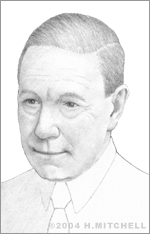George De Mestral
It may be difficult to imagine a world without Velcro®, but the fastening mechanism did not exist before George de Mestral created it in 1955.
Born in Switzerland on June 19, 1907, de Mestral earned an electrical engineering degree from the Ecole Polytechnique Federale de Lausanne. The idea for Velcro® came to him when he was doing one of the things he loved most: hiking. He and his dog passed through a patch of brush and were quickly covered with burrs, which clung firmly to fur and clothing. When he returned home, de Mestral pulled one of the burrs off of his trousers and took it to his microscope. He saw that the burr had tiny hooks all over it that were able to hold tightly to the fabric loops in his clothing or strands of hair in animal fur. This was nature’s way of ensuring that the seeds inside the burr would be spread far and wide for increased chance of successful planting.
This design intrigued de Mestral, who thought, why not create a fastening system employing these same ideas? He decided to experiment with his idea using two sides: one with lots of small hooks and the other with lots of tiny loops. At first, his loops and hooks were not sized correctly and did not cling as ferociously as he wanted them to. He began working with a weaver in France who helped him design tough hooks and soft loops that produced the desired effect. They also found that nylon, not cotton, was the best material for the hooks. The design was perfected in 1955.
That year, de Mestral patented his locking tape, calling it Velcro®, a combination of the words “velour” and “crochet” (French for “velvet” and “hooks”). He established Velcro Industries and was soon selling more than sixty million yards per year.
Later, de Mestral sold his rights to Velcro®. He died on February 8, 1990. Velcro® has since become a practical, effective, and ubiquitous material, used in an endless list of products and applications including clothing, shoes, sports equipment, luggage, wallets, toys, and home furnishings. It has even been used in heart surgery and by NASA to keep objects “tied down” during space shuttle missions. Today, it is made from a variety of materials as well, including steel and plastic.


